Note: This website was automatically translated, so some terms or nuances may not be completely accurate.
Behind the scenes of the underground dungeon that appeared at Tokyo Game Show 2022!
Customer Experience (CX) continues to evolve daily.
How can Dentsu Inc.'s creative approach contribute to the CX domain, now demanded across every scenario?
To explore this potential, members of Dentsu Inc.'s CX specialist unit, the "CXCC" (Customer Experience Creative Center), share insights on CX and creativity in this series. This is "Monthly CX" ( For more on Monthly CX, click here ).
The "Tokyo Game Show 2022" was held at Makuhari Messe in September 2022. Following 2021, the virtual "TOKYO GAME SHOW VR 2022" (hereafter TGSVR2022) was also open for a limited four-day period.
How much did VR (virtual reality) evolve in 2022? What was the user response? And what challenges became apparent precisely because it was implemented? We spoke with Ryo Suetomi, a planner at CXCC/Dentsu Lab Tokyo who was involved in the TGSVR2022 project.
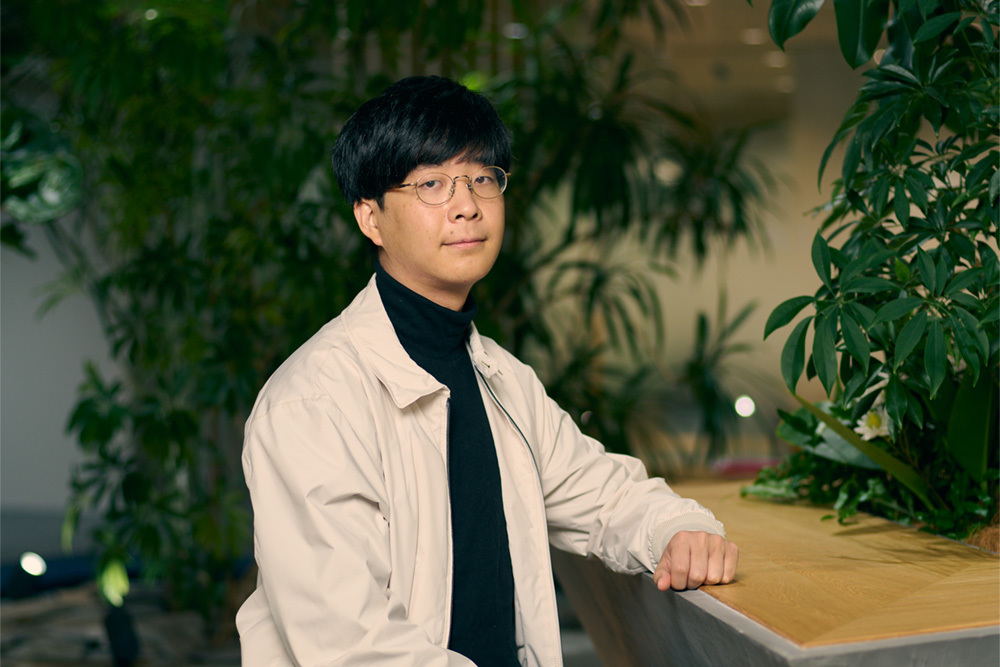
Dentsu Inc.
Customer Experience Creative Center
Dentsu Lab Tokyo
Planner
Studied architecture and urban planning at university and graduate school. Passionate about spatial design and experience design, both real and virtual. Since joining the company, has worked on numerous large-scale event projects centered around XR.
"The Game Show Becomes the Game." Tokyo Game Show's Hybrid Format
Monthly CX: Following last year's success, this year's TGSVR was also very well-received. First, could you explain the relationship between the Tokyo Game Show and TGSVR?
Suehiro: The Tokyo Game Show is an event held at Makuhari Messe since 1996 by the Computer Entertainment Supplier's Association (CESA). In 2020 and 2021, during the COVID-19 pandemic, it was held online. In 2022, it returned to an on-site event for the first time in two years, simultaneously offering online streaming and TGSVR as a hybrid format. The online streaming involved live-streaming various programs on different video platforms, while TGSVR allowed participants to experience the metaverse using PCs or VR headsets.
Monthly CX: While VR events have been ongoing since 2021, what were the plans and structure for 2022?
Suehiro: While TGSVR 2021 focused on enjoying exhibitors' booths in VR, this second iteration took the experience further. TGSVR 2022 officially carried the message: "The game show becomes the game."
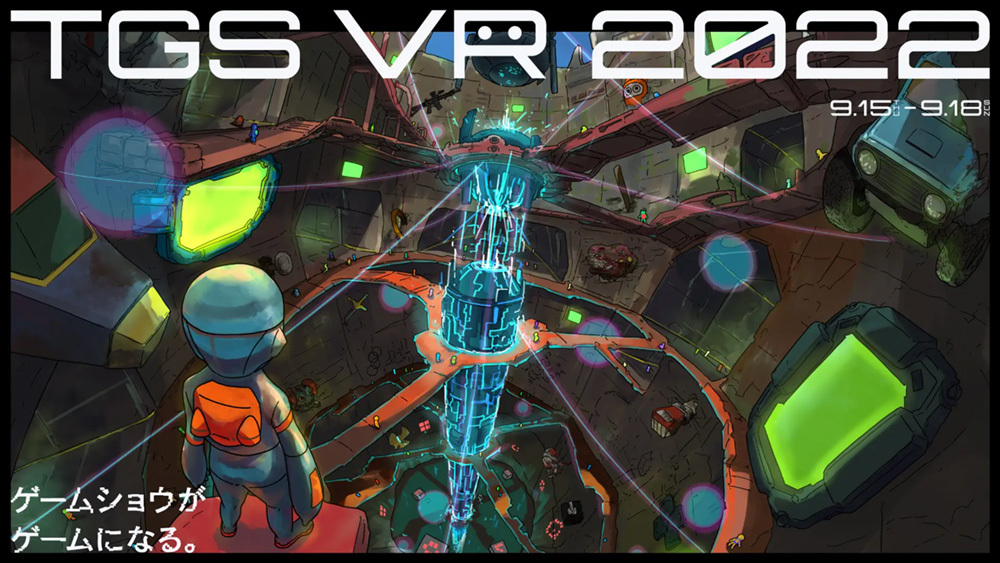
Specifically, we designed a metaverse representing "a world where a dungeon appeared beneath Makuhari Messe," accessible for VR exploration.
Within this world, users explored the dungeon, visited exhibition booths, and completed "quests." Furthermore, items obtained by completing quests could be equipped by avatars, enabling avatar customization.
Looking at user participation numbers, the total number of participants reached 398,000 (compared to 210,000 in 2021), with an average stay time of 33 minutes (compared to 27 minutes), showing significant growth.
Monthly CX: Both attendance and session duration are remarkably high! The "game-like enjoyment" aspect likely contributed. What was the operational structure?
Suehiro: The project was led by Dentsu Inc. Business Co-creation Bureau, with Dentsu ZERO and Dentsu CXCC handling the creative aspects. Production partners included ambr, which provided the platform, handled planning, production, and direction, and Diffuse Entertainment, which was responsible for the actual spatial production. The overall concept design and story were discussed and developed collaboratively between Dentsu Inc. and ambr.
The Unique Value of VR Experiences, Meticulously Designed for Hybrid Events
Monthly CX: Regarding the CX experience design of the dungeon exploration game, what were the key points?
Suehiro: Typical metaverse events are designed to be easily understandable for everyone, given the wide range of participant literacy levels. However, this time we challenged ourselves with a design assuming many participants were game-savvy enough to follow even complex stage designs.
To avoid a simplistic experience, we used the motif of "game strata buried beneath Makuhari Messe." Participants explore the dungeon by visiting exhibition booths to clear quests, feeling the history of gaming as they progress.
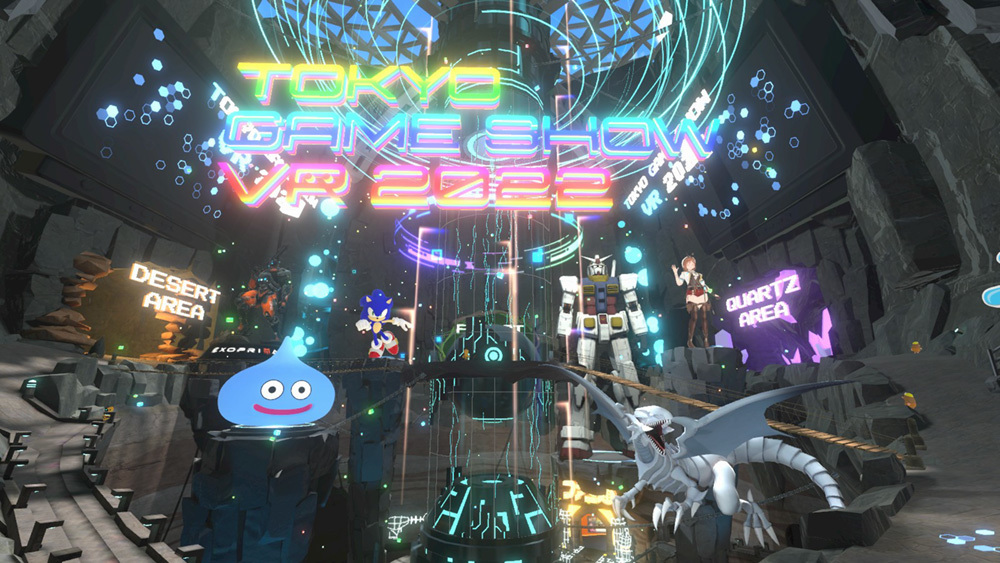
However, we carefully balanced this to avoid hindering the core game show experience. For instance, during planning, we considered areas accessible only if your avatar wore items obtained by clearing quests. We ultimately decided against implementing this complexity. It would be cool to have exhibits you could only explore while under a "poison status" effect, like in an RPG.

Monthly CX: Since this runs concurrently with the physical Tokyo Game Show, were there any considerations you made?
Suehiro: We made sure it wouldn't detract from the real event's attendance. We aimed for each to be a distinct experience, not competing with each other.
Monthly CX: It wouldn't make sense if people who would normally go to the venue just did everything online instead. How did the exhibiting manufacturers react to the online exhibition?
Suehiro: Thanks to our 2021 track record, manufacturers were more receptive to the concept of VR exhibits and cooperated by providing 3D model assets. This allowed us to feature many appealing game characters within the VR space, creating a lively atmosphere. For participants, meeting their favorite characters is part of the fun, so I believe we delivered a world that met their expectations.

Monthly CX: I tried it myself, and the experience of looking up at huge monuments of characters from games in the 3D space was quite impactful. It was also interesting how the game makers' exhibits and quests blended together so well.
Suehiro: We also put effort into collaborations with sponsoring companies outside the game industry. For example, if your avatar drank a beverage at a beverage company's booth, an awakening effect would appear on the avatar. Or, visiting an apparel company's booth would grant you special clothing. We aimed to provide experiences that conveyed each company's unique characteristics. Having your avatar's appearance change likely enhanced the sense of immersion, right?

VR space as an experiment. What challenges need solving?
Monthly CX: Regarding providing experiences using VR technology, are there any challenges?
Suehiro: For example, when quantifying and measuring user experiences, "watching a video once" on a website and "experiencing VR once" differ in the "quality" and "intensity" of that single experience. But comparing these numerically is difficult, right? I also feel VR is still a genre where its effects are hard to measure quantitatively.
Monthly CX: As a creator, what challenges do you personally feel?
Suehiro: Since VR and the metaverse are still in their infancy, the era where most people commonly use VR is still ahead. For creators, this dawn period offers unique excitement, but it also brings challenges.
At this TGSVR, we offered two participation methods: using VR goggles and using a PC (experiencing it on a flat display without stereoscopic vision). Exceptionally for this type of event, VR goggle users were numerous, with 58.5% of participants experiencing the event using VR goggles. While the nature of a game show contributed to this figure, the number of people owning VR goggles costing tens of thousands of yen is still limited.
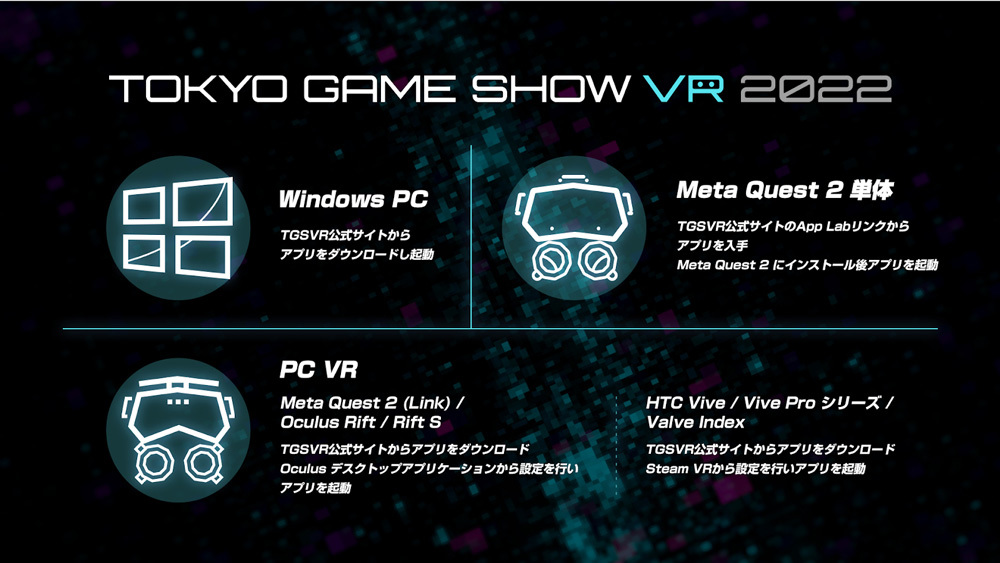
Moving forward, to target a broader audience, we need to carefully balance the richness of the experience with ease of access. As creators, we want to design VR experiences that aren't just enjoyable with VR goggles, but also accessible via PCs and smartphones.
Monthly CX: I see. What were the technical challenges?
Suehiro: As the number of simultaneous connections increased, we faced the challenge of not being able to render everyone's avatars due to communication and device limitations.
Experiences like music concerts, where the value lies in "many people enjoying it together," differ from those suited for exhibitions like game shows. However, we should consider what number of participants is appropriate for rendering at an exhibition.
We need to establish a standard for appropriate attendance levels—whether it leads to a positive experience where "more people make it livelier and more fun," or a negative one where "crowds make exhibits hard to see."

Monthly CX: So it's about the presentation as part of the production. From my experience, since the story involved exploring a dungeon, I didn't really notice how many other participants were there. It seems the required experience design changes depending on what you want people to experience there.
Suehiro: When creating VR spaces like the metaverse, the production workflow isn't fully established yet. There are various challenges in ensuring the project team develops with a shared vision.
For example, it's difficult to get approval within the company or team when explaining concepts to people without VR knowledge. To prevent deliverables from being limited to what approvers can imagine, we need to devise ways to share concrete visions—like creating prototypes for them to actually experience.
Another challenge is how "VR as advertising content" can compete with game makers and others who may enter the VR market more seriously in the future.
Monthly CX: It's true that there might be a significant difference between content created as advertising and what game developers produce.
Suehiro: Yes. As an overall marketing challenge, I'm always thinking about what happens when advertising content faces competition from the entertainment industry.
Monthly CX: How do you foresee the future of VR unfolding, Mr. Suetomi?
Suehiro: I can't see it clearly yet, but to draw an analogy, the current VR scene resembles the early days of the internet when many people enjoyed personal homepages. Numerous individual creators are producing and releasing VR content. While personal homepages were later swallowed up by large services like SNS, I hope VR can evolve into a space where companies and individual creators coexist more effectively.
Personally, I also create VR spaces to hang out with friends outside of work, but I still feel the barrier to entry is a bit high for everyone to freely enjoy it. I think hardware innovation advancing another step or two will help us cross that chasm. Also, since wearing VR goggles at work usually gets you weird looks, creating designs and an image that make goggle wearers look cool seems surprisingly important.
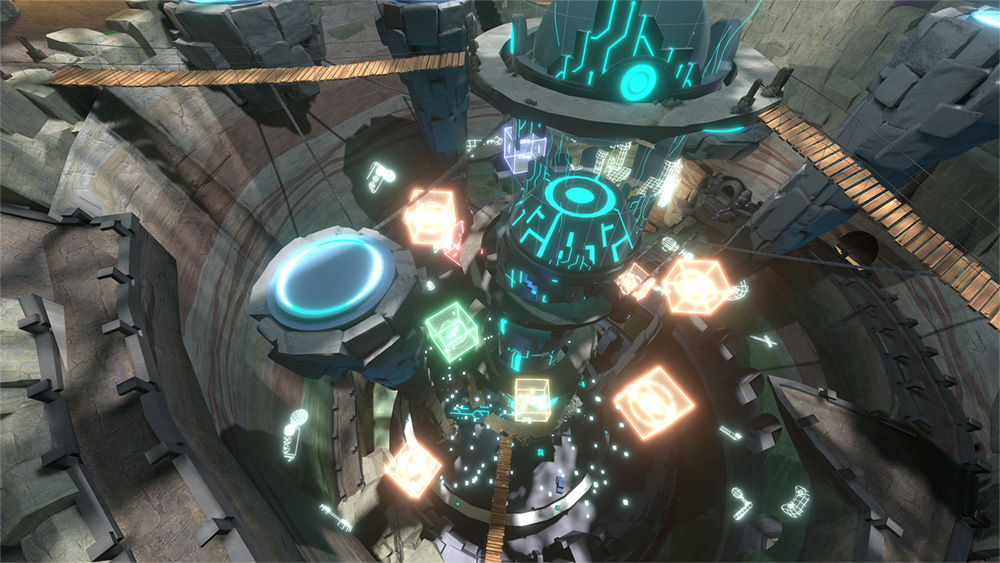
The metaverse doesn't have to be purely functional—it can have useless spaces too.
Monthly CX: What kind of VR experiences or metaverse would you like to create going forward, Mr. Suetomi?
Suehiro: VR as advertising content is like a "tourist spot" – you visit once, feel satisfied, and that's it. TGSVR2022 was limited to four days, but I want to build a place for medium-to-long-term community, creating a world where experiences accumulate.
The ability to use spaces disposable and instantly reach destinations is a strength of virtual environments. However, I think it would be great to create places where the time spent and the events experienced linger.
Current VR is polarized between recreating "your own room" like VRChat (a social VR platform) and "tourist destinations" like TGSVR. It would be nice to have more "station"-like places in between rooms and tourist destinations. Having places to stop by on the way to your destination, where encounters happen, would be fun too.
Monthly CX: The efficiency of warping from your room to your destination was a strength of virtual reality, but now that you mention it, wanting that "waste" in between makes sense.
Suehiro: For detour spots, we could create spatial midpoints, or use algorithms to recommend other places and teleport there. Similarly, for meeting people, we want to explore how VR can express this—whether through matching systems or letting users initiate conversations themselves.
Monthly CX: If TGSVR were to happen again in 2023, based on the past two years, is there anything you'd like to try?
Suehiro: It's a well-worn phrase, but I'd like to design an experience that's more immersive than before. If we can create an experience that not only lets people enjoy the setting but also delivers such a sense of presence that they genuinely believe it on a cognitive level, we could achieve something truly different.
Monthly CX: I see. This time, you used the meta-perspective of "the basement of Makuhari Messe," so there was some of that element. But you mean that by developing not just technical effects like visual effects, but also the world-building and the structure of the story, you can create a sense of reality and immersion. That sounds really interesting if it can be realized. I'm looking forward to it!
(Editor's Note)
TGSVR has evolved significantly over the past two years. However, VR and the metaverse are still in a trial-and-error phase, and there's hope for further development in the future. It will be exciting to see how these challenges in such a cutting-edge space, where interesting things are likely to happen, will blossom going forward.
This interview was conducted in collaboration with 'CX Creative Studio note' ( learn more about CX Creative Studio note here ). We're also working with Dentsu Digital Inc.'s CX Creative team, not just the Dentsu CXCC team, to gather and share a broader range of case studies. If you're interested, please check them out as well.
If you have requests for future topics or case studies, please send a message to the Monthly CX Editorial Department via the contact page below. Thank you for your continued readership.
Was this article helpful?
Newsletter registration is here
We select and publish important news every day
For inquiries about this article
Back Numbers
Author

Suehiro Ryo
Dentsu Inc.
Customer Experience Creative Center Dentsu Lab Tokyo
Planner
Studied architecture and urban planning at university and graduate school. Passionate about spatial design and experience design, both real and virtual. Since joining the company, has primarily worked on large-scale event projects centered around XR.

Monthly CX Editorial Department
Dentsu Inc.
CXCC (CX Creative Center)
The editorial team for "Monthly CX," a series where members of Dentsu Inc.'s CX-specialized division "CXCC" share insights on CX and creativity. By covering outstanding CX creative success stories within the agency or company, we unravel the essence and potential of CX creativity. Core members are Yoko Kibata, Hiroshi Koike, Nao Otani, Hirono Okumura, Yutaro Kosugi, Espin, Keisuke Saito, Kenji Oda, Hirozumi Takakusagi, and Motofumi Kanasaka, all belonging to CXCC.







